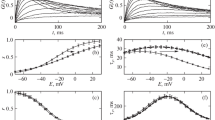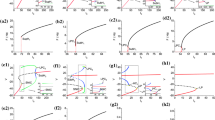Abstract
The patch clamp method is used for studying the characteristics of slow sodium channels responsible for coding of nociceptive signals. Quantitative estimates of rate constants of transitions of “normal” and pharmacologically modified activation gating mechanisms of these channels are obtained. A mathematical model of the type of Hogdkin–Huxley nociceptive neuron membrane is constructed. Cometic acid, which is a drug substance of a new nonopioid analgesic, is used as a pharmacological agent. The application of bifurcation analysis makes it possible to outline the boundaries of the region in which a periodic impulse activity is generated. This boundary separates the set of values of the model parameter for which periodic pulsation is observed from the values for which such pulsations are absent or damped. The results show that the finest effect of modulation of physical characteristic of a part of a protein molecule and its effective charge suppresses the excitability of the nociceptive neuron membrane and, hence, leads to rapid reduction of pain.
Similar content being viewed by others
References
B. V. Krylov, V. B. Plakhova, and I. V. Rogachevsky, “Substance with sedative effect,” US Patent No. 8 476 314 B2 (July 2, 2013).
I. L. Yachnev, V. B. Plakhova, S. A. Podzorova, T. N. Shelykh, I. V. Rogachevsky, and B. V. Krylov, Med. Chem. 8, 14 (2012).
A. L. Goldin, J. Exp. Biol. 205, 575 (2002).
O. P. Hamill, A. Marty, E. Neher, B. Sakmann, and F. Sigworth, Pflugers Arch. 391, 85 (1981).
W. Almers, Membrane: Ionic Channels (Mir, Moscow, 1981), pp. 129–236.
P. Chevrier, K. Vijayaragavan, and M. Chahine, Br. J. Pharmacol. 33, 576 (2004).
H. L. Read and R. M. Siegel, Neuroscience 75, 301 (1996).
Y. A. Kuznetsov, Appl. Math. Sci. 112, 710 (2004).
J. Lai, F. Porreca, J. C. Hunter, and M. S. Gold, Ann. Rev. Pharmacol. Toxicol. 44, 371 (2004).
Author information
Authors and Affiliations
Corresponding author
Additional information
Original Russian Text © O.E. Dik, T.N. Shelykh, V.B. Plakhova, A.D. Nozdrachev, S.A. Podzorova, B.V. Krylov, 2015, published in Zhurnal Tekhnicheskoi Fiziki, 2015, Vol. 85, No. 10, pp. 131–134.
Rights and permissions
About this article
Cite this article
Dik, O.E., Shelykh, T.N., Plakhova, V.B. et al. Application of bifurcation analysis for determining the mechanism of coding of nociceptive signals. Tech. Phys. 60, 1545–1548 (2015). https://doi.org/10.1134/S1063784215100126
Received:
Published:
Issue Date:
DOI: https://doi.org/10.1134/S1063784215100126




